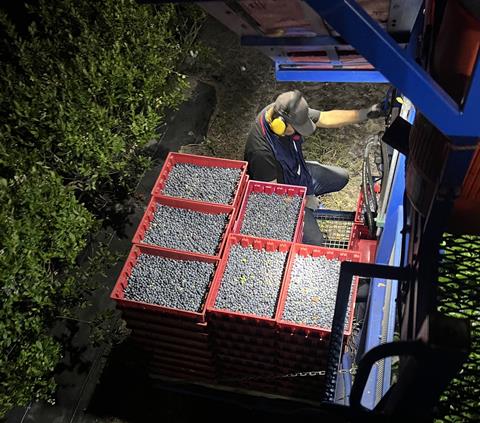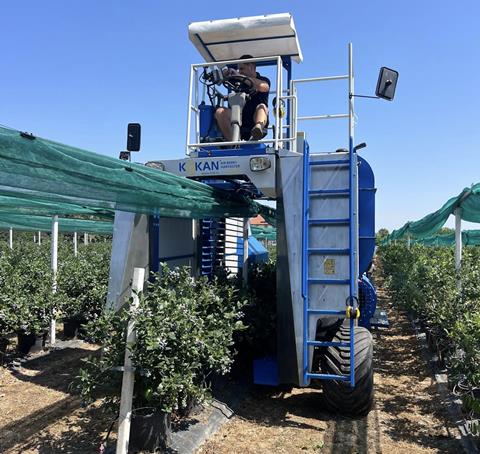When a devastating storm hit Serbia in 2000, thousands of fruits fell prematurely from their branches. But what seemed like an agricultural disaster became the spark for one of the most innovative breakthroughs in berry harvesting technology

Momčilo Kokanović, a mechanical engineer working at a local power plant in Serbia, once spent his free time socialising with nearby farmers. Through these conversations, he learned about their persistent challenge: the seasonal labour shortage that plagued raspberry harvesting. Determined to help, Kokanović began thinking about mechanical solutions.
Then came the storm of 2000. As he surveyed the damage – berries and other fruits scattered across the ground by powerful gusts of wind – an idea struck him.
“If a storm can shake berries from plants without destroying them, why couldn’t we replicate that process in a controlled way?”
This moment of inspiration would eventually transform BSK into a leading manufacturer of air-flow berry harvesters.
“Our Air Harvesting Technology exactly imitates storms with pulsating air jets of controlled velocity and frequency,” explains Kokanović, CEO of BSK and son of the company’s founder. “The plant could be shaken without physical contact, avoiding damage to berries and plants.”
Innovation through understanding
What sets BSK apart in the competitive harvesting equipment market isn’t just its storm-inspired technology – it’s the company’s commitment to solving real-world problems through continuous innovation. The company has developed several breakthrough features that address specific industry challenges.
Its pneumatic pillows, made from special rubber filled with air that absorbs energy when berries fall from branches, eliminate bruising. The innovative comb disc catching system reduces berry spillage to less than 5 per cent, maximising harvest efficiency. For situations requiring more aggressive harvesting, such as end-of-season plant cleaning, BSK’s finger system increases both force and speed when needed.
“While berry harvesting using air flow has been utilised by equipment manufacturers previously, our solution introduces a significant innovation by independently controlling air speed and shaking frequency. This breakthrough has proved game-changing for growers in the field,” Kokanović notes.
The development process hasn’t been without challenges. Unlike other agricultural equipment, berry harvesters can only be tested during harvesting seasons, meaning a full-year wait between iterations. This constraint has made BSK’s engineers particularly focused on getting innovations right first time.
From raspberries to global markets
BSK began with raspberries, leveraging Serbia’s position as a global leader in frozen raspberry production. However, the company quickly expanded to blackberries and currants before discovering their sweet spot: fresh blueberry harvesting. Today, approximately 90 per cent of BSK’s customers are fresh blueberry growers, with only 10 per cent focusing on raspberries and blackberries for the IQF (individually quick frozen) industry.
This shift reflects the economics of mechanised harvesting. While Serbia dominates frozen raspberry production, most local farms are small family operations (averaging less than half a hectare) often located on steep hillsides – challenging terrain for mechanised equipment. BSK’s harvesters are designed for the global market, where larger operations can justify the investment.

Economics of efficiency
The numbers tell a compelling story. Depending on the model, a BSK harvester can collect over 500kg of berries per hour. Considering that an average worker harvests 40-50kg per day (of 8-10 hours), one BSK machine replaces 90-100 seasonal workers.
“Client adoption typically follows a predictable progression,” Kokanović explains. “In plantations not initially designed for mechanised harvesting, growers typically achieve 10-15 per cent mechanical harvesting in their first year, scaling to approximately 40 per cent in the second year, and reaching 60 per cent or higher by the third year. However, when plantations are specifically prepared for mechanised operations, farmers can achieve 50 per cent mechanical harvesting immediately in their first year.”
The investment makes economic sense for operations of 15ha or more, though European clients with smaller plots –sometimes just 3-5ha in Italy – have found success with BSK harvesters. The machines can handle slopes up to 15 per cent and harvest approximately 4ha of blueberry fields daily, depending on terrain and crop conditions.
Global reach and market adaptation
BSK harvesters now operate from Canada to New Zealand, with significant presence in the UK, Romania, Italy and Turkey. In the US – where the company entered five years ago – BSK has found its largest market in Washington and Oregon states.
The American market presented unique challenges and opportunities. “American blueberry growers are farmers in the true sense of the word, unlike many European plantations where investors from other businesses employ professional farm managers,” Kokanović observes. “Americans focus on high yields, while Europeans prioritise fruit quality.”
US producers proved both traditional and practical, preferring local suppliers and being slower to adopt new technologies. BSK overcame this through established local distributors and excellent service support. Within two years of market entry, they delivered over 40 harvesters to US customers.
The 2022-23 market downturn and rising interest rates significantly impacted sales, but BSK successfully navigated these challenges through continued innovation. US growers, facing competition from Chile, Peru and Mexico, increasingly view mechanised harvesting as key to maintaining competitiveness against countries with lower labour costs.
Currently, about 50 per cent of US blueberry acreage uses mechanical harvesting, compared to just a few percent in Europe. However, most BSK clients use harvesters as one tool among many, combining machine harvesting for later pickings with manual labour for the first couple of harvests, when fruit quality commands premium prices.
Future Innovations
BSK continues to push technological boundaries. Current development focuses on implementing optical sorting directly on harvesters, which will significantly increase grower efficiency. The company is also improving software functions for automatic parameter adjustment and developing air harvesting technology for cherries and apples, maintaining their focus on fresh fruit markets.
Looking ahead, BSK plans to offer comprehensive solutions – a one-stop shop that includes orchard design consultation, specialised hail and sun protection systems, and mechanised harvesting equipment.
For berry producers considering mechanisation, Kokanović emphasises that technology cannot replace sound agricultural management. “Regardless of the flexibility and efficiency that mechanised harvesting provides, producers must still carefully time their harvests,” he says. “The quality of fruit on the bush determines the quality in the crate – neither human picker nor machine can correct poor management decisions.”
Kokanović’s recommendation? Design future orchards specifically for mechanised harvesting. “Labour challenges and unpredictable weather conditions during harvesting will become increasingly pronounced,” he warns.
From a storm-swept raspberry field to a globally recognised harvesting solution, BSK’s journey exemplifies how innovation born from necessity can transform entire industries. As labour shortages intensify and quality demands increase worldwide, the company’s air-flow technology shows that sometimes the best solutions come from nature itself.



